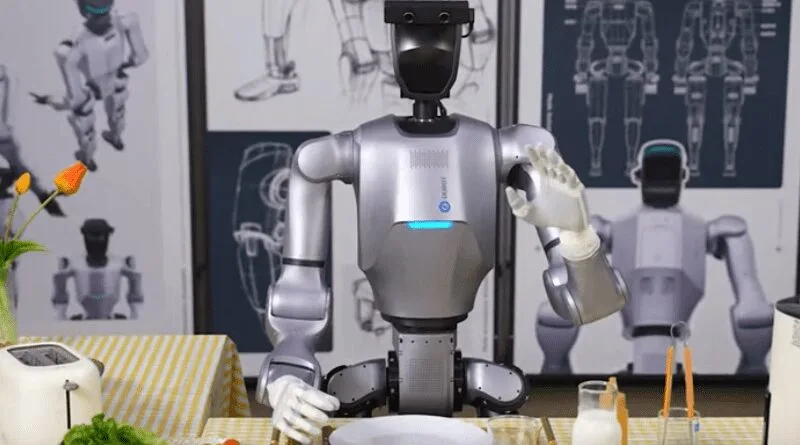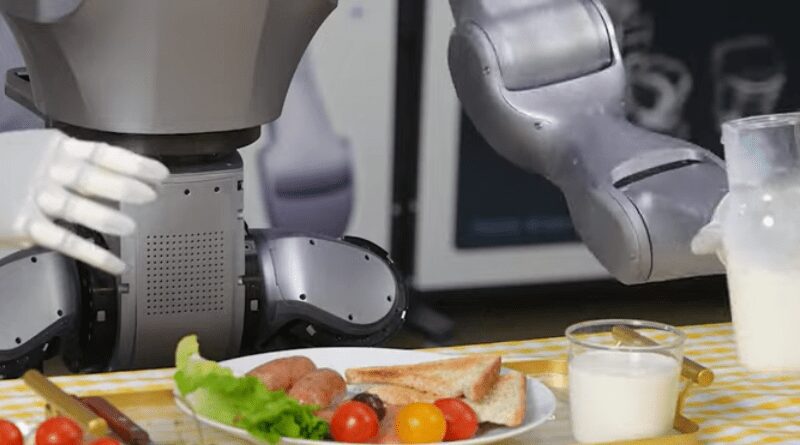A Chinese humanoid robot cooks using virtual reality

Can a robot perform complex human tasks with the same efficiency?
It seems very possible after Dobot Robotics demonstrated its humanoid robot, Atom, skillfully cooking a steak using remote-controlled virtual reality (VR) technology.
This represents a major breakthrough in the field of culinary robotics and a huge step forward in the development of robots capable of mimicking complex human skills.
Key features of this robot
Remote control using virtual reality (VR): Atom can be remotely controlled from a distance of approximately 1,800 kilometers (1,118 miles).
During the demonstration, an engineer wearing a VR headset in Guangdong Province controlled the robot in Shandong Province.
The VR headset accurately captured the engineer’s hand movements, and the robot mimicked them in real time.
Performing complex cooking tasks
The robot demonstrated exceptional ability to perform precise and complex cooking tasks, such as:
- Drying a steak with a paper towel.
- Precisely pours oil into a frying pan.
- Easily flips a steak.
- Sprinkles salt with its fingers, mimicking human dexterity.

Highly dexterous and precise:
According to Dobot, the Atom robot has an accuracy of 0.05 mm, allowing it to perform the precise movements required in cooking.
Atom’s capabilities:
The prototype of the Atom robot was launched in March of this year (2025).
It is priced at approximately $27,500 (199,000 Chinese yuan).
It has 28 degrees of freedom, providing great flexibility in its movement.
It is equipped with five-fingered hands that enable it to grasp objects and perform precise tasks.
The company not only boasted about Atom’s capabilities in cooking a steak; it also demonstrated the robot preparing a nutritious breakfast by placing toast, topping it with lettuce and fruit, and pouring milk.
The Atom robot can also walk with human-like motion, but currently, only the upper body is controlled via virtual reality, and walking is autonomous or limited.
Broader Applications Beyond Cooking
This technology goes beyond cooking. The ability to remotely control robots with high precision over long distances opens the door to broad applications in areas such as:
- Performing hazardous tasks in unsafe environments, such as nuclear inspections.
- Healthcare applications, such as remote surgery.
- Performing complex household tasks.
- Space exploration.
Compared to other technologies
NASA reportedly has similar technology with its humanoid robot “Valkyrie.” However, Dobot has been able to address the networking challenges associated with remote control over long distances in a way that NASA has not yet achieved.
Global Marketing and Delivery
Dobot recently began delivering Atom robots globally, with Japan receiving the first batch. This represents an important step toward widespread commercialization of this technology.
Chinese Humanoid Robot
China aspires to be a global leader in the production of humanoid robots and is making rapid and remarkable progress in this regard. This development is not limited to one aspect, but rather encompasses multiple aspects, such as design, functionality, and applications.
Key aspects of China’s development in humanoid robotics:
China aims to be a global leader in the production of humanoid robots by 2025, with sales revenue estimated at approximately $1.14 billion.
Transition from Experiment to Commercialization:
The Chinese humanoid robotics sector is currently moving from the pilot phase to large-scale production and commercialization, thanks to declining costs and the completion of supporting technical systems. This is similar to what China has achieved in the production of electric cars.
Leading Companies:
Several Chinese companies are working to accelerate the use of humanoid robots in real-world work environments. For example, UBTECH Robotics announced a plan to deploy 20 humanoid industrial robots by the first half of 2025. Automakers such as BYD and NIO have also begun integrating humanoid robots into their factories for tasks such as quality inspection and parts assembly.
Dobot Robotics:
Dobot Robotics is a leader in this field and has begun global deliveries of its “Atom” robot.
Technological Developments and Advanced Capabilities:
China is focusing on developing “embodied intelligence,” the integration of artificial intelligence into humanoid robots. This sector is expected to witness significant growth, with the domestic market size expected to reach approximately 103.8 billion yuan by 2030, representing nearly 45% of the global market share.
Precise Control and Flexibility:
Chinese robots boast precise control capabilities and high flexibility, enabling them to perform complex tasks that require precise manual skills, such as cooking, as in the Dobot Atom robot, or assembling parts in factories.
Emotional Expression:
Engineers at the X-Robots factory in Dalian have successfully developed humanoid robots capable of emotional expression, focusing on improving their facial expressions and emotions to be more realistic.
Sensing and Interaction:
China aims to achieve breakthroughs in environmental sensing, motion control, and human-machine interaction capabilities.
Learning and Training:
Technologies are being developed to enable robots to learn from humans and accurately mimic their movements and behaviors.
Government Support and Infrastructure
- National Strategy: Robotics development has been a policy goal for China for a decade, and the sector enjoys broad government support.
- Investment Funds: Beijing has allocated a $183 billion investment fund for the development of automated robots.
- Training Facilities: China is preparing to launch its first national robot training facility in July 2025, which will be dedicated to preparing various prototypes for use in a variety of scenarios. This center aims to train more than 100 different types of robots and build a library of basic skills.
- Patents: China leads research in this field, accounting for 78% of all robot patents over the past two decades, compared to 3% for the United States, according to a Citigroup note issued last year.
Diverse Applications
- Manufacturing: Humanoid robots are increasingly being used in factories, particularly in the automotive industry, to perform assembly and inspection tasks.
- Services: In addition to cooking, humanoid robots could find applications in areas such as healthcare, logistics, education, and even entertainment.
- Hazardous Tasks: China aims to use robots for dangerous and simple tasks, freeing humans to focus on advanced tasks that require discretion.
Challenges and Competition
Despite the tremendous progress, challenges associated with the development of humanoid robots remain, such as:
- Improving their ability to handle unstructured environments.
- Developing more advanced artificial intelligence technologies.
- Ensuring safe interactions between robots and humans.
- Global competition is fierce, particularly with American companies like Tesla and Boston Dynamics.
Overall, China has demonstrated a strong commitment to investing in humanoid robotics research and development, making it a key player in shaping the future of this technology.
Also read:
a-self-driving-tesla-taxi-crashes-into-a-parked-vehicle
a-chinese-humanoid-robot-cooks-using-virtual-reality
brain-computer-interfaces-when-telepathy-becomes-a-technological-reality




